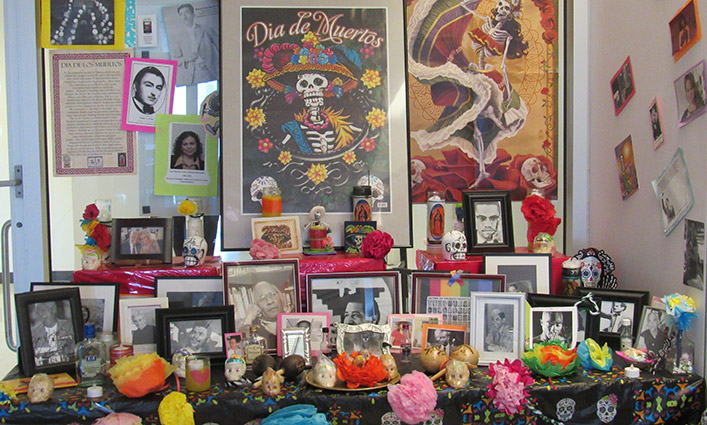
John Jay, a proud Hispanic Serving Institution (HSI), celebrated Latinx Heritage Month from September 17 through November 1. Recognizing the contributions that Latinx people have made to the United States, this extended celebration was loaded with events covering everything from serious topics on race, colonialism, and the current crisis in Puerto Rico, to lighter events like a musical performance by Folklore Urbano and a trip to Museo Del Barrio. To round out the last days of our Latinx Heritage Month celebration, La Voz, the Department of Latin American and Latina/o Studies with the co-sponsorship of other clubs, held a Day of the Dead Celebration filled with food, music, and a presentation, along with a screening of the movie Coco. Here are some highlights of the events and thoughts from our students attending them.

“The history books are so absent of the Latinx experience in the U.S.” —José Luis Morín
Understanding What It Means To Be An HSI
Professor José Luis Morín opened up his HSI Speaker Series presentation with a list of assertions about people of Latin American descent in the United States: • Most are foreign born. • Most are not U.S. citizens. • They don’t want to learn English. • They don’t want to assimilate. • They don’t pay taxes. • Immigrants from Latin America are more prone to criminal behavior than U.S.-born citizens. After he finished listing off the statements, Morín asked the audience, “Which statements are true and which statements are false? If you’re answering that some of these statements are true, that should be concerning,” said Morín, because all of them were false. He added that many of his students, when asked the same question anonymously, thought some of the statements were true. Morín connected the dots from these troubling misconceptions, to the history of Latin Americans in the U.S., to the needs and concerns our Latinx students are facing today.

“The history books are so absent of the Latinx experience in the U.S.,” he said. “When I ask students if they see themselves reflected in books, almost no hands go up. If students think so little of who they are, how can they succeed?” He went on to explain how segregation and Jim Crow took over where slavery left off, for both African-Americans and Latinx people. “The word ‘greaser’ was the counterpart to the n-word,” said Morín, explaining the wide-reaching effects of racial profiling for both groups of people. His eye-opening presentation ended with a Q&A session on how to effectively support the 51% Hispanic/Latinx population currently attending John Jay.
Día De Los Muertos
Celebrating the love and respect people have for their deceased family members is a time-honored tradition for the Latinx community. That’s why so many students were excited to celebrate with food, friends, and festivities on October 31 and November 1. We chatted with some of these students to learn more about their feelings about the event, and joined them for a screening of Coco, an animated film depicting a young boy’s experience with his family and Día De Los Muertos.
Maria Negrete, ’18
What is the Day of the Dead?
“The Day of the Dead is a celebration, not only for the Mexican community but all throughout Latin America. We celebrate the lives of our loved ones and remember the people and ancestors that came before us.”


Andres Portoviejo, ’20
What does it mean to be Latinx?
“For me it's the culture, the food, and the language. There are so many things that contribute to it, and there isn't just one definition.”

Alondra Aea, ’20
Why is Coco an important movie for the Latinx community?
“In general, this was one of Disney's first Latino-based movies. When Coco came out, it was very different from what we were used to seeing. It hit those points of bringing culture into Disney and appreciating Mexican heritage. I identify as Mexican. It was nice seeing my culture portrayed in a manner that speaks positively about it rather than the negative portrayal that media shows. Having children see this culture portrayed so beautifully puts us in a platform to show that Mexicans are much more than what they see in the media.”

Karina Davila, ’20
What does it mean to be Latinx?
“In between the Latinx community, there is a lot of intersectionality and it's not only one box that we check off. You can be queer and Latinx. You can be undocumented and Latinx. You can be from different countries and still be Latinx. It means different things.”

Melanie Dominguez, ’19
Why is Coco an important movie for the Latinx community?
“Coco is an important movie because it demonstrates a lot of the cultures that many people should know. When people view this movie, they get to experience a bit of the Latinx culture from Latin American countries.”
Gilianne Oyola, ’19
Why is this a good way to end Latinx Heritage Month?
“At the end of the month it's Día de Los Muertos, and this a great way to get together and appreciate a movie that represents our culture well and that got everything accurate. It’s not a parody. It’s accurate about what the Mexican culture is like.”




